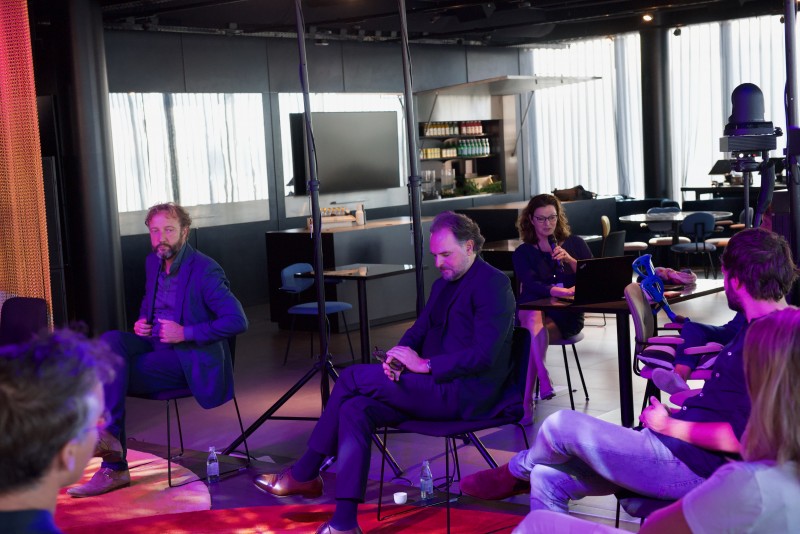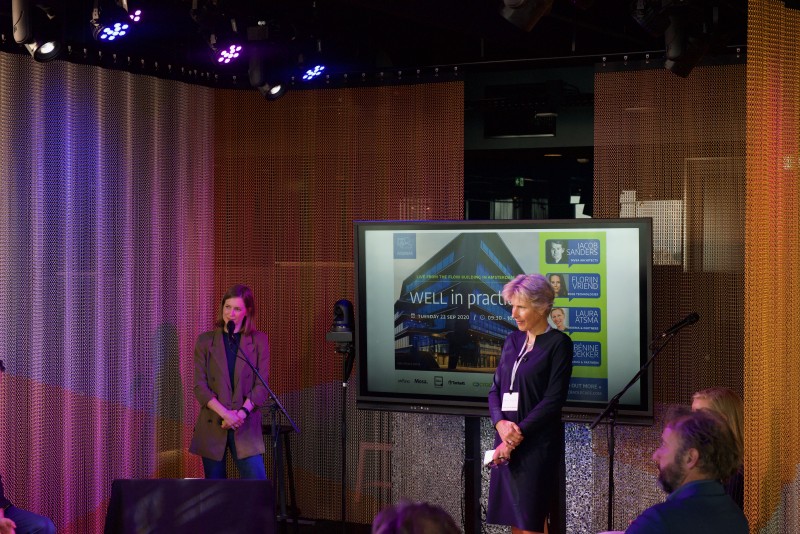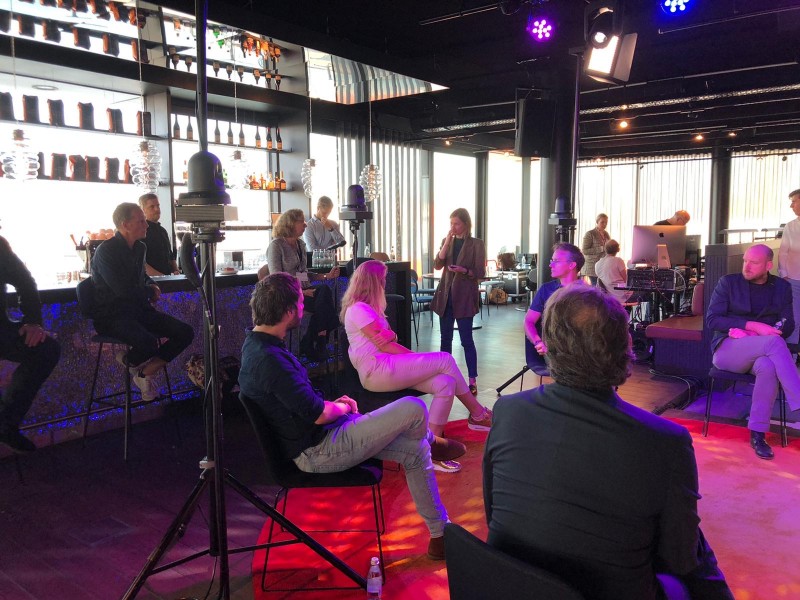The first Cradle to Cradle Cafe Webinar
A summary of the webinar
Presentations and videos
Jeroen Schilder en Jozien Timmers
An impression ….
WELL in practice
is the topic of today’s Cradle to Cradle Café being presented digitally to interested parties from FLOW Amsterdam. The following is a brief report of the three lectures.
FLOW is made to perform
The first presentation was given by Jeroen Schilder and Jozien Timmers of MVSA Architects. Their office in the Amsterdam Houthaven district was constructed according to WELL principles. The building is the first in the Netherlands to be awarded Platinum in accordance with the WELL V2 Building Standard. ‘As architects, MVSA has been engaged in sustainability for years,’ explains Timmers. Their projects have included Haga hospital, De Puls, Holland Casino in Venlo, and the ING headquarters in the Zuidas district. Their designs are about much more than just a sustainable building, and instead focus on a building that allows its users to utilize it in a way that maximizes health. The design of their own office goes even further. They wanted users to be able to come to work in a building in a ‘Flow State of Mind’, allowing them to give their very best consistently. To accomplish this aim, they looked at the requirements that WELL imposes on the design of a building. It starts with the shell, which in this case has exceptional insulation, including triple glazing. Users enter the building through an extremely unusual entrance hall. ‘The entrance area really does justice to the multi-tenant concept,’ explains Timmers. ‘It has an interesting dual function. The hall is used to receive guests, of course, but it can be fully closed off so can also function as a large meeting area for gatherings. The LED façade wall has a different appearance every day, changing the atmosphere of the building from day to day.’ In addition, further thought was given to the air quality and thermal comfort of the building. Clean air is a central component of the building, and users can adjust the air on every floor to their needs using an app. The lights in the building have also been developed specifically for FLOW. The colours are adjusted according to the time of day to match the ‘flow’ of the users. By using recycled materials, noise on the shop floor has also been reduced. All in all, it is a dynamic work environment with the body and mind at its core. ‘The University of Lausanne is currently researching well-being and the results of the healthy environment,’ adds Timmers.
Some of the questions that were asked:
- Can you explain more about the construction of the building?
We took that into account from the very outset. The most important thing was the building’s flexibility, making easier to introduce changes.
- Why have you opted for some design solutions for Flow?
At MVSA, we seek combinations in the design and user demands. There is a wide range of combinations. We use our expertise from the past and try to make it better using the ingredients that we have at our disposal at the time.
- The use of materials like concrete, glass, aluminium, and steel is very specific; how do you reflect on the sustainability level of those materials?
The construction of Flow involves steel beams and columns in dry connections and mostly prefabricated floor islands. This method of construction is relatively easy to disassemble and to reuse. Most of the concrete used in Flow is prefabricated and therefore very suitable for reuse. Aluminium is known to be a very sustainable material once processed, and low maintenance. It is also very good for recycling because it doesn’t need a lot of energy. The façade is an aluminium curtain wall system of dry connections and therefore also easy to disassemble. What you can conclude from this is that we have used materials that may not be very sustainable in processing (aluminium and concrete), but that we have focused more on the low maintenance aspect and good recycling opportunities.
- Acoustics: all the materials used seem hard; how are the requisite acoustic demands met?
It may seem to be hard, but we have used acoustic materials in strategic locations and integrated them into the design – such as the perforated climate ceiling with acoustic panels on top, the allusion ceiling panels around the cores, fronts/doors of storage furniture made from acoustic wooden panels, and the use of carpet tiles. In the gym, restaurant, 360, and private dining, we have used acoustic sprayed ceilings to improve the acoustics.
- How does the use of Cradle to Cradle materials contribute to a better rating for the WELL Building Standard? And was that a significant advantage that you took into account during your design of The Flow Building?
The WELL materials section handles the reduction of human exposure to hazardous material ingredients (VOCs, etc.). So, in general, the use of safe and healthy materials. This is also an important part of Cradle to Cradle materials. The use of these healthy and Cradle to Cradle materials helps to achieve a higher WELL rating in that sense. During the design, as mentioned above, that did not play a major role in the selection of materials because the focus was more on low maintenance and recycling possibilities. However, it was an important theme in the design and selection of the materials used in the interior.
Well-being on the shop floor
The second lecture was delivered by Florijn Vriend, Product Lead for Well-Being at EDGE technologies. She talked about healthy people in healthy buildings. Why is it so important that the user is central? Research shows that happy, valued employees are more than twice as productive as their less engaged counterparts, so it’s easy to see why ‘well-being’ is so high up on the agenda of architects, interior designers, and HR/facility managers. What role does an attractive interior play in enhancing well-being on the shop floor? It’s not technical, but about zooming in on the end user. According to Vriend, there are two important points that need to be considered in the design – that people change and that our current working climate offers only limited space for emotional variation. Consequently, the office landscape must offer a wide variety of work spaces. She has looked at what the future is likely to bring for well-being on the shop floor – how correct use of the environment, light, plants, and interior in an office can influence health, happiness, self-confidence, collaboration, and productivity. As such, Vriend sees the WELL Building Standard as a powerful tool for creating a healthy work environment. In her presentation, she explained the concept of WELL and the differences between version 1 and version 2. She also explained how WELL differs from BREEAM, which focuses more on sustainability as opposed to well-being. Nevertheless, the two concepts both seek to promote the health and productivity of building users. In her presentation, Vriend referred to different websites where people can find relevant information. Very interesting!
The audience was asked if anyone present had worked with WELL.
The general response to use of a WELL-certified building was positive – even though it may seem a little American, something which has improved recently.
Some questions for Florijn:
- How does the use of Cradle to Cradle materials contribute to a better rating for the WELL Building Standard? And is it a significant advantage when rating as a WELL AP?
By using Cradle to Cradle materials, there is a much better chance of the VOCs remaining at a lower level. This is an important feature within WELL and hard to obtain when choosing furniture, for instance. Since the launch of V2, WELL also recognizes Cradle2Cradle certifications: ‘The recently launched WELL v2™ recognizes Cradle to Cradle Certified™ under the standard’s Enhanced Material Precaution and Material Transparency requirements, which are designed to minimize the impact of hazardous materials and to promote material transparency across the building product supply chain”- https://www.c2ccertified.org/news/article/well-recognizes-c2ccertified
If ‘rating as a WELL AP’ is understood to mean taking the exam and being listed as WELL AP, it has a couple of advantages. When you apply your WELL AP status to a project, it gives an innovation point, so you immediately achieve a feature this way (I02, WELL Accredited Professional). Of course, it helps if you understand the standard and how the certification process works. Many also register as WELL AP to gain more in-depth knowledge of health and well-being in the built environment – so it is a great investment either way.
- Which sources are being used to examine the ecological footprint of materials used in construction?
To a certain extent this is part of LEED and BREEAM. But this is a topic that is very much under construction, and there is still a lot to be done! For our buildings at EDGE, we plot all materials used in ‘Madaster’. Although this may not be a direct examination of the ecological footprints, it does ensure that materials can be reused when a building is dismantled. There are some companies that use materials from old buildings and construction sites that reuse materials in renovation or new-build projects.
There are currently many initiatives, such as the Circular Economy, also focussing on materials in the built environment. I am sure that there are many more other great initiatives globally, but more emphasis on this is very welcome throughout entire industry!
Nature in interior design
The final speaker of the day was an architect with Fokkema & Partners, Bénine Dekker. Fokkema & Partners is renowned for its interior design work. In her presentation, Dekker talked about BREEAM and WELL and her findings, and offered some examples. She is proud of the numerous ambitious buildings that she has collaborated on. A particularly prestigious project was Unilever, which involved a significant quantity of recycled material. One of Fokkema’s reasons for switching over to WELL is the attention paid to the well-being of the user when obtaining the certificate – something that is central to the philosophy at Fokkema. Nature must play a central role in designs, i.e. applying biophilia and using natural materials, plus introducing light and appropriate furniture and materials. She explained that in order to obtain a certificate, you need to satisfy VOC levels. This means that both the material and interior of the office need to be chosen with care and must satisfy the strict VOC standards of WELL. Correct use ensures correct output. Dekker used examples, evidence, and figures to demonstrate how WELL is a fine example of good and healthy practice. She adds, ‘Learn from one another and look at the benefits of both sustainability programmes – that’s what will make the difference.’
Some questions for Bénine:
- Thanks for sharing your thoughts on the design for the Edge… Could you tell us more about the ecological footprint of the materials used in your design?
The WELL Building Standard focusses on the health of users in a building (or community). In this case, the focus was not on the ecological footprint of materials but on VOC reduction.
- How does the use of Cradle to Cradle materials contribute to a better rating for the WELL Building Standard? And was that a significant advantage that you took into account during your design of EDGE Olympic?
C2C materials Gold or higher are mentioned by the WELL Building Standard V1, as well as other labels such as Greenguard Gold products, EU Ecolabel products, LEED standard, etc.





















